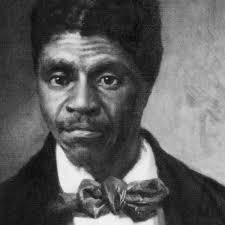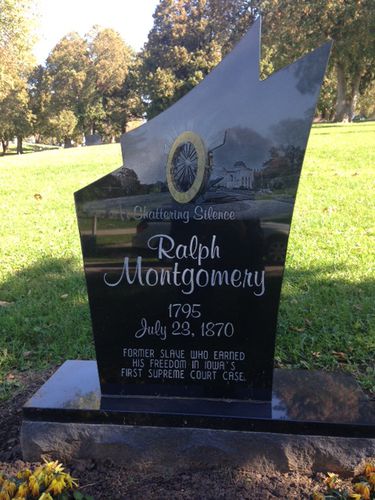
Shattering Silence: Farmer Helped Slave Find Freedom and Racial Equality in Iowa
How much is your freedom worth? In 1834, it was worth $550 for a slave named Ralph Montgomery, whose tumultuous story would involve hope for freedom, dashed dreams, bounty hunters, tremendous risk and a groundbreaking court decision that continues to inspire Iowans to shatter the silence on the volatile issue of racial inequality.
“He was born into slavery, a piece of property allowed only to serve others,” noted the article “Iowa Supreme Court’s First Case Freed a Slave,” which ran in 2015 in The Courier newspaper in Waterloo. “Even his name belonged to someone else.”
He came into the world as Rafe Nelson, probably in about 1795. But early on Nelson became Ralph Montgomery, named for his slave master in Virginia. After being taken to Kentucky by his owner and namesake, Ralph was described as “quite a chunk of a field hand” in his 20s. Despite that fact — or perhaps because of it—Ralph Montgomery, the slave master, sold his slave to a brother.
The new owner, William Montgomery, then sold Ralph in 1830 to a son, Jordan Montgomery. Newspaper accounts of the era described Jordan Montgomery as “kind and indulgent.”
Jordan Montgomery subsequently took Ralph to Palmyra, Mo., located northwest of Hannibal, the famed Mississippi River town. Ralph served his owner for about two years in Palmyra, which was roughly 60 miles south of the Iowa border.
“Here [at Palmyra], Ralph met a white man named Ellis Schofield, who had just returned from a trip to the Upper Mississippi region’s lead mining regions. He told such glowing tales of boundless wealth to be acquired there that Ralph became “seized with a burning desire to go and work out his own salvation,” according to the Janesville Gazette in Wisconsin.
Seeking freedom in Iowa
Jordan Montgomery and Ralph worked out a written agreement sometime around 1834 or 1835, where Ralph committed to pay $550, with interest, for his freedom. He traveled northward, “strong of purpose and light of heart,” according to a story in the Janesville Gazette in 1870.
Ralph went to work mining lead in Dubuque in the Iowa Territory. After five years, however, he hadn’t been able to repay the debt. The problem was the high cost of living. Ralph apparently struggled simply to pay room and board, according to historian Dorothy Schwieder, author of the book Iowa: The Middle Land.
At the same time, Jordan Montgomery experienced financial difficulties, struggling to repay a $4,000 bank loan. When two men from Virginia offered to return Ralph to his cash-strapped master in Missouri for a fee of $100. Jordan Montgomery wasn’t inclined to write off Ralph as bad debt, so he accepted the bounty hunters’ offer.
Shattered dreams
The Virginians swore an affidavit in front of a justice of the peace that Ralph was a fugitive. Court official ordered the local sheriff to assist the bounty hunters. The group found Ralph at his mineral claim, put him in handcuffs and loaded him onto a wagon.
Alexander Butterworth, variously described as a farmer, businessman, concerned eyewitness and noble-hearted Irishman in the Dubuque area, was plowing a nearby field and saw the kidnapping. Butterworth dashed to Dubuque to notify Thomas Wilson, an associate judge on the newly formed Supreme Court of the Territory of Iowa.
Let’s take it to court
Judge Wilson ordered the sheriff to follow the bounty hunters who had seized Ralph and return bring Ralph to Dubuque. Armed with a writ of habeas corpus and accompanied by the sheriff, Butterworth galloped to the rescue, noted historical accounts.
The Virginians had managed to get Ralph to Bellevue, Iowa, along the Mississippi River to board a riverboat that would transport him back to Missouri. Butterworth and the sheriff reached the dock just in time. They ordered the riverboat captain to return Ralph to Dubuque for a hearing before Judge Wilson.
Ralph’s case would turn out to be the first decided by the Territory of Iowa’s Supreme Court, which had been established in 1838 in Burlington. The court’s inaugural case was titled “In the matter if Ralph (a colored man), on Habeas Corpus.”
The legal question was whether Jordan Montgomery had a legitimate claim to demand Ralph’s return. Jordan Montgomery’s lawyers argued when Ralph relocated to the Iowa Territory, slavery was not specifically prohibited in Iowa under the so-called Missouri Compromise of 1820, since a local legislature had not taken additional action to ban it. Jordan Montgomery’s lawyers also claimed Ralph was a fugitive slave, since he had failed to fulfill his contract and should be returned to Missouri under conditions of the federal Fugitive Slave Act.
Ralph Montgomery’s attorney, David Rorer, argued that Ralph became a free man when, by consent of his master, Ralph moved to Iowa. Rorer, and rising star in the Iowa Territory, claimed that his client was neither a slave nor a fugitive, in part because he entered a contract “which presupposes a state of freedom.” Rorer also cited an English case in which it was ruled that a slave having lived in a free country could not be taken to another land that would again lead him into slavery. According to Rorer, the only obligation Ralph owed was to raise the $550 for his former owner in Missouri.
Rorer also cited Chapter 23 of the Book of Deuteronomy in the Bible, which says, in part: “Thou shalt not deliver unto his master the servant which is escaped from his master unto thee: He shall dwell with thee, even among you.”
Ruling delivered on Independence Day 1839
The Iowa Supreme Court conceded Ralph Montgomery should repay Jordan Montgomery — with one key stipulation. “It is a debt which he ought to pay, but for the non-payment of which no man in this territory can be reduced to slavery,” wrote Charles Mason, the first chief justice of the Iowa Supreme Court.
Mason concluded Ralph Montgomery “should be discharged from all custody and constraint, and be permitted to go free while he remains under the protection of our laws.” The Iowa Supreme Court declared Ralph Montgomery a free man on Independence Day, July 4, 1839.
In their opinion, the court justices wrote, “When, in seeking to accomplish his object, (the claimant) illegally restrains a human being of his liberty, it is proper that the laws, which should extend equal protection to men of all colors and conditions, should” intervene.
The unanimous ruling established the tradition in Iowa’s courts of ensuring the rights and liberties of all the people of the state. Years later, the state legislature adopted Iowa’s motto: “Our liberties we prize and our rights we will maintain,” which stands as a permanent reminder that the freedoms in this state are freedoms for all.

What happened to Ralph?
Ralph Montgomery remained in Iowa for the rest of his life. According to the State Historical Society of Iowa, he showed up one day to work in Judge Wilson’s garden in 1840 (one year after the Iowa Supreme Court ruling in his favor). “I ain’t paying you for what you done for me,” Ralph said. “But I want to work for you one day every spring to show you that I never forget.”
Ralph Montgomery stayed in Dubuque the rest of his life, a free man. While not much is known about how he lived the remainder of his life, we do know he continued to mine lead and was a familiar figure around town. While the Dubuque Times in 1870 credited Ralph Montgomery with finding several valuable lodes, he eventually fell in hard times, either through being swindled or by gambling, according to conflicting accounts. During his later years, he lived in the county poor house, according to the Dubuque Times. He succumbed to smallpox, a disease he contracted while nursing a sick patient, during his time in Dubuque’s pest house. He died on July 23, 1870.
(A pest house, short for pestilence house, was a quarantine facility typically found throughout American communities in the late 1800s. Before the development of hospitals, people afflicted with communicable diseases such as tuberculosis, cholera, smallpox or typhus were placed in pest houses.)
Ralph was buried in the city cemetery which became in Jackson Park in later years, according to Encyclopedia Dubuque. When that cemetery was closed, Ralph’s remains were among those moved to Linwood Cemetery, where they were buried in a mass grave.
Ralph Montgomery’s case offered much different outcome than Dred Scott case
Eighteen years later, the lessons of Ralph Montgomery’s case seemed to be forgotten when Missouri slave Dred Scott pleaded his case for freedom in court. On March 6, 1857, the U.S. Supreme Court handed down its decision on Sanford v. Dred Scott, a case that intensified national divisions over the issue of slavery.
In 1834, Dred Scott, a slave, had been taken to Illinois, a free state, and then to the Wisconsin Territory, an area where the Missouri Compromise of 1820 prohibited slavery. Scott lived in Wisconsin with his master, Dr. John Emerson, for several years before returning to Missouri, a slave state. In 1846, after Emerson died, Scott sued his master’s widow for his freedom on the grounds that he had lived as a resident of a free state and territory. He won his suit in a lower court, but the Missouri Supreme Court reversed the decision.

Dred Scott
Scott appealed the decision. A federal court decided to hear the case on the basis of the diversity of state citizenship represented. After a federal district court decided against Scott, the case came on appeal to the U.S. Supreme Court, which was divided along slavery and antislavery lines; although the Southern justices had a majority.
During the trial, the antislavery justices used the case to defend the constitutionality of the Missouri Compromise, which had been repealed by the Kansas-Nebraska Act of 1854. The Southern majority responded by ruling on March 6, 1857, that the Missouri Compromise was unconstitutional and that Congress had no power to prohibit slavery in the territories. Three of the Southern justices also held that African Americans who were slaves or whose ancestors were slaves were not entitled to the rights of a federal citizen, and therefore had no standing in court.
These rulings all confirmed that, in the view of the nation’s highest court, under no condition did Dred Scott have the legal right to request his freedom. The Supreme Court’s verdict further inflamed the irrepressible differences in America over the issue of slavery, which in 1861 erupted with the outbreak of the American Civil War.
Shattering Silence
It would take the Civil War, the passage of the 13th Amendment to abolish slavery and the civil rights’ movement of the mid-20th century to help create a more just America for everyone, regardless of race. The battle is not yet over, as evidenced by the Black Lives Matter movement, police brutality (in tragic cases such as the death of George Floyd in Minneapolis in late May 2020) and the resulting civil unrest that has swept America.

Shattering Silence in Des Moines near Iowa Supreme Court (photo from Des Moines Public Art Foundation)
Even as racial-charged protests turned into riots in downtown Des Moines during the weekend of May 30-31, a 30-foot sculpture near the Iowa Supreme Court pointed to the hope that has endured in Iowa from the beginning.
“Shattering Silence,” which features a ring made of limestone quarried in Dubuque, was designed by artist James Ellwanger and installed in 2009 on the 170th anniversary of the Iowa Territory Supreme Court’s landmark decision in the Ralph Montgomery case. (Photo credit for the winter image of Shattering Silence that I used with this post goes to Jason Mrachnia.)
The stunning sculpture stands at the top of the hill overlooking the Des Moines skyline. The Iowa Art Council has called the piece a commemoration of “those moments when Iowa has been at the forefront of breaking the silence of inequality and commemorates those Iowans who refused to stand by silently when they saw injustice.”
Former slave who made history in Iowa leaves powerful legacy
Back in Dubuque, local residents raised money in recent years to install a tombstone to honor Ralph Montgomery. On October 1, 2016, community leaders unveiled a monument to Ralph in the Linwood Cemetery to highlight Iowa’s ongoing role in shattering the silence on the issue of racial inequality.
“We are gathered today to honor a man who has brought such honor to this state by helping us discover not only who we were at that time, but who we would hope to become today,” said Mark Cady, former chief justice of the Iowa Supreme Court who passed away in November 2019. “Ralph Montgomery suffered through the indignity of slavery to rise and stand against it and help forge a great meaning …of our collective belief in equality, both then and now.”

Want more?
I invite you to read more of my blog posts if you value intriguing Iowa stories and history, along with Iowa food, agriculture updates, recipes and tips to make you a better communicator.
If you’re hungry for more stories of Iowa history, check out my top-selling “Culinary History of Iowa: Sweet Corn, Pork Tenderloins, Maid-Rites and More” book from The History Press. Also take a look at my other books, including “Iowa Agriculture: A History of Farming, Family and Food” from The History Press, “Dallas County” and “Calhoun County” book from Arcadia Publishing. All are filled with vintage photos and compelling stories that showcase the history of small-town and rural Iowa. Click here to order your signed copies today! Iowa postcards are available in my online store, too.
If you like what you see and want to be notified when I post new stories, be sure to click on the “subscribe to blog updates/newsletter” button at the top of this page, or click here. Feel free to share this with friends and colleagues who might be interested, too.
Also, if you or someone you know could use my writing services (I’m not only Iowa’s storyteller, but a professionally-trained journalist with 20 years of experience), let’s talk. I work with businesses and organizations within Iowa and across the country to unleash the power of great storytelling to define their brand and connect with their audience through clear, compelling blog posts, articles, news releases, feature stories, newsletter articles, social media, video scripts, and photography. Learn more at www.darcymaulsby.com, or e-mail me at yettergirl@yahoo.com.
Let’s stay in touch. I’m at darcy@darcymaulsby.com, and yettergirl@yahoo.com.
Talk to you soon!
Recent Posts
- Do Press Releases Still Work?
- Erasing History? Budget Cuts Threaten to Gut Ag History at Iowa State University
- Machines that Changed America: John Froelich Invents the First Tractor in Iowa
- Bob Feller on Farming, Baseball and Military Service
- Classic Restaurants of Des Moines: A Taste of Thailand Served the "Publics" and Politics
- Want to Combat Fake News? Become a Better Researcher
Categories
- Achitecture
- Agriculture
- Architecture
- baking
- barbeque
- Barn
- breakfast
- Business
- Communication Tips
- Conservation
- content
- cooking
- Crime
- Dallas County
- Economical
- Farm
- Featured
- Food
- Food history
- health
- Iowa
- Iowa food
- Iowa history
- marketing
- Photography
- Recipes
- Seasonal
- Small town
- Storytelling
- Uncategorized
- writing
Archive by year
- 2023
- 2022
- 2021
- 2020
- When Agriculture Entered the Long Depression in the Early 1920s
- The Corn Lady: Jessie Field Shambaugh and the Birth of 4-H in Iowa
- Sauce to Sanitizer: Cookies Food Products Bottles Hand Sanitizer Made with Ethanol
- Myth Busting: No, Your Pork Doesn't Come from China
- Long Live Print Newsletters! 5 Keys to Content Marketing Success
- Shattering Silence: Farmer Helped Slave Find Freedom and Racial Equality in Iowa
- Meet Iowa Farmer James Jordan, Underground Railroad Conductor
- George Washington Carver Rose from Slavery to Ag Scientist
- Remembering the African-American Sioux City Ghosts Fast-Pitch Softball Team
- Want to Combat Fake News? Become a Better Researcher
- Classic Restaurants of Des Moines: A Taste of Thailand Served the "Publics" and Politics
- 2019
- The Untold Story of Iowa’s Ag Drainage Systems
- Stop Rumors Before They Ruin Your Brand
- Finding Your Voice: The Story You Never Knew About "I Have a Dream"
- Warm Up with Homemade Macaroni and Cheese Soup
- Can a True Story Well Told Turn You into a Tom Brady Fan?
- Baking is for Sharing: Best Bread, Grandma Ruby’s Cookies and Other Iowa Favorites
- 4 Key Lessons from Bud Light’s Super Bowl Corn-troversy
- Could Your Story Change Someone’s Life?
- What To Do When the Travel Channel Calls
- Tex-Mex Sloppy Joes and the Magic of Maid-Rite in Iowa
- How Not to Invite Someone to Your Next Event--and 3 Solutions
- We Need FFA: Iowa Ag Secretary Mike Naig Reflects on His FFA Experiences
- From My Kitchen to Yours: Comfort Food, Conversation and Living History Farms
- Smart Marketing Lessons from an Uber Driver--Listen Up!
- Hog Trailers to Humidors: Two New Iowa Convenience Stores Reflect “Waspy’s Way”
- A Dirty Tip to Make Your Social Media Content More Shareable
- Are You on Team Cinnamon Roll?
- Senator Grassley on Farming: Any Society is Only Nine Meals Away From a Revolution
- Why We Should Never Stop Asking Why
- What’s the Scoop? Expanded Wells’ Ice Cream Parlor Offers a Taste of Iowa
- Independence, Iowa’s Connection to the Titanic and Carpathia
- Memories of Carroll County, Iowa, Century Farm Endure
- Iowa's “Peacemaker Pig” Floyd of Rosedale Helped Calm Racial Tensions
- 2018
- How to Cook a Perfect Prime Rib
- How Did We Get So Rude?
- Mmm, Mmm Good: Soup’s on at the Rockwell City Fire Department
- Quit Using “Stupid Language”
- In Praise of Ham and Bean Soup
- Recalling a Most Unconventional—and Life-Changing--FFA Journey
- Events Spark Stories That Help Backcountry Winery Grow in Iowa
- Sac County Barn Quilt Attracts National Attention
- Doing Good, Eating Good at Lytton Town Night
- Young Entrepreneur Grows a Healthy Business in Small-Town Iowa
- Digging Deeper: Volunteers Showcase Thomas Jefferson Gardens in Iowa
- How to Tell Your Community’s Story—with Style!
- DNA Helps Sailor Killed at Pearl Harbor Return to His Family
- It’s Time to Be 20 Again: Take a Road Trip on Historic Highway 20
- The Biggest Reason You Shouldn’t Slash Your Marketing Budget in Tough Times
- Are You Telling a Horror Story of Your Business?
- Pieced Together: Barn Quilt Documentary Features Iowa Stories
- Unwrapping Storytelling Tips from the Candy Bomber
- Barn Helped Inspire Master Craftsman to Create Dobson Pipe Organ Builders
- Butter Sculptures to Christmas Ornaments: Waterloo Boy Tractor Celebrates 100 Years
- Ag-Vocating Worldwide: Top 10 Tips for Sharing Ag’s Story with Consumers
- 2017
- Growing with Grow: Iowa 4-H Leader Guides 100-Year-Old 4-H Club for 50 Years
- High-Octane Achiever: Ethanol Fuels New Driver Tiffany Poen
- Shakespeare Club Maintains 123 Years of Good Taste in Small-Town Iowa
- Iowa’s Ice Queen: Entrepreneur Caroline Fischer’s Legacy Endures at Hotel Julien Dubuque
- Darcy's Bill of Assertive Rights: How to Communicate and Get What You Need
- Celebrating Pi Day in Iowa with Old-Fashioned Chicken Pot Pie
- Cooking with Iowa’s Radio Homemakers
- Top 10 Tips to Find the Right Writer to Tell Your Company’s Stories
- The “No BS” Way to Protect Yourself from Rude, Obnoxious People
- Learning from the Land: 9 Surprising Ways Farmers Make Conservation a Priority
- Leftover Ham? Make This Amazing Crustless Spinach and Ham Quiche
- Iowa’s Lost History from the Titanic
- Coming Soon--"Dallas County," a New Iowa History Book!
- How to Clean a Burned Pan in 6 Simple Steps
- Iowa Beef Booster: Larry Irwin Takes a New Twist on Burgers
- Get Your Grill On: How to Build a Better Burger
- "Thank God It’s Over:" Iowa Veteran Recalls the Final Days of World War 2
- How to Thank Veterans for Their Military Service
- Imagine That! Writers, Put Your Reader Right in the Action
- Remembering Ambassador Branstad’s Legacy from the 1980s Farm Crisis in Iowa
- Busting the Iowa Butter Gang
- Lightner on Leadership: “Everyone Has Something to Give”
- Show Up, Speak Up, Don’t Give Up
- Small - Town Iowa Polo Teams Thrilled Depression - Era Crowd
- Ethanol:Passion by the Gallon
- Cruising Through Forgotten Iowa History on Lincoln Highway
- Why I'm Using a Powerful 500-Year-Old Technology to Make History--And You Can, Too
- 5 Ways a “History Head” Mindset Helps You Think Big
- Behind the Scene at Iowa's Own Market to Market
- Let’s Have an Iowa Potluck with a Side of History!
- Iconic State Fair Architecture: Historic Buildings Reflect Decades of Memories
- Iconic State Fair Architecture- Historic Buildings Reflect Decades of Memories
- Iowa Underground - How Coal Mining Fueled Dallas County's Growth
- Ultra-Local Eating: Jennifer Miller Guides CSA, Iowa Food Cooperative
- The Hotel Pattee and I are Hosting a Party—And You’re Invited!
- Tell Your Story—But How?
- Mediterranean Delights: Iowa Ag Influences Syrian-Lebanese Church Dinner
- 6 Steps for More Effective and Less Confrontational Conversations
- 6 Steps for More Effective and Less Confrontational Conversations!
- 6 Ways to Motivate Yourself to Write—Even When You’re Not in the Mood
- Always Alert-How to Stay Safe in Any Situation
- Does Accuracy Even Matter Anymore?
- Soy Power Shines at Historic Rainbow Bridge
- Free Gifts! (Let’s Talk Listening, Stories and History)
- 2016
- How to Connect with Anyone: Lessons from a Tornado
- Soul Food: Lenten Luncheons Carry on 45-Year Iowa Tradition
- Top 3 Tips for Writing a Must-Read Article
- Darcy's Top 10 Tips to Better Writing
- Top 8 Tips for Building a Successful Freelance Business
- 10 Steps to Better Photos
- Reinventing the Marketer of 2010
- Extreme Writing Makeover
- My Top Social Media Tips for Farmers: REVEALED!
- Honoring the Legacy of Rural Iowa's Greatest Generation
- Iowa's Orphan Train Heritage
- Dedham’s Famous Bologna Turns 100: Kitt Family Offers a Taste of Iowa History
- Iowa Barn Honors Pioneer Stock Farm
- Darcy's Top 10 Tips for Better Photos
- Soup and Small-Town Iowa Spirit
- Savoring the Memories: Van's Café Served Up Comfort Food for Six Decades
- Mayday, Mayday—The Lost History of May Poles and May Baskets in Iowa
- Iowa's Vigilante Crime Fighters of the 1920s and 1930s
- Very Veggie: Iowan's Farm-Fresh Recipes Offer Guilt-Free Eating
- Iowa Public TV's "Market to Market" Features Expedition Yetter, Agri-Tourism, Des Moines Water Works' Lawsuit
- 62 Years and Counting: Calhoun County, Iowa, Families Maintain 4th of July Picnic Tradition
- “A Culinary History of Iowa” Satisfies: Iowa History Journal Book Review
- For the Love of Baking: Lake City's Ellis Family Showcases Favorite Iowa Farm Recipes (Caramel Rolls, Pumpkin Bars and More!)
- Remembering Sept. 11: Iowa Community’s Potluck Honors America
- Talking Iowa Food and Culinary History on Iowa Public Radio
- Talking "Stilettos in the Cornfield," Taxes, Trade and More on CNBC
- FarmHer #RootedinAg Spotlight--FFA Attracts More Women to Careers in Ag
- Rustic Cooking Refined: Iowan Robin Qualy Embraces Global Flavors
- Voice of Reason: Iowa Pork Producer Dave Struthers Offers Top 10 Tips to Speak Up for Ag
- Iowa Eats! Why Radio Iowa, Newspapers and Libraries are Hungry for "A Culinary History of Iowa"
- Iowa Turkeys Carry on National Thanksgiving Tradition
- Riding with Harry: 2016 Presidential Election Reflects Truman's Iowa Revival at 1948 Plowing Match in Dexter
- All Aboard! Rockwell City’s “Depot People” Offer a Taste of Iowa History
- Is This Iowa's Favorite Appetizer?
- O, Christmas Tree! Small Iowa Towns Celebrate with Trees in the Middle of the Street
- Slaves Escaped Through Dallas County on Iowa’s Underground Railroad
- Adel Barn Accents Penoach Winery in Iowa
- Celebrating New Year's Eve in Style at a Classic Iowa Ballroom
